Knee SafetyKnee Safety - A Quick OverviewBy Bigger Faster Stronger Published: Injury prevention to the knees depends on two factors. First, you must strengthen the muscles, tendons and ligaments which surround the knee joint. Second, you must perform every physical action with the knee in perfect alignment. Perfect alignment means straight alignment, which must occur everywhere--on the field, on the court, in the weight, during stretching or even sitting in a chair. Knee Safety Correct Alignment Image 1 - Knees Over Toes: Get into a squatting stance and look at the middle of each knee. If you were to drop a string straight down, where would it land? The string would land in the middle of the foot which is perfect. During any athletic movement including squatting, the knees should always be over the middle of the toes. Image 2 - Knees Behind Toes & Weight On Heels: Practice balancing with the feet entirely on the floor. The heels should never come off the floor when squatting. Use a partner as shown for balance. Squat down with an erect upper body and concentrate on a “hips back-knees straight” posture. Do not Squat with knees forward of the toes. Knee Safety & The Squat Image 3 -The Cure For Knees In: When squatting, the knees-in problem will surface on the upward movement and this puts unwanted pressure on the medial collateral ligaments. The first step is to yell “knees” which is a signal to force the knees out over the toes. If this does not work, lightly tap the inside of the knee as shown. Image 4 -The Cure For Knees Out: Squatting with the knees out will put unwanted pressure on the lateral collateral ligaments. The knees-out problem can easily be corrected by just widening out the athlete’s stance. Widen out the stance until the knees are aligned directly over the toes. Image 5 - The Cure For Knees Forward: Squatting with the knees way forward causes unwanted pressure on the patella area. Use the partner system and practice squatting with the hips back and with the knees vertically as straight as possible. If the knees are past the tips of the toes, that is too far forward. Image 6 - The Correct Knee Squatting Position: Correct Parallel Squats will strengthen the muscles, tendons and ligaments which surround the knee from top to bottom. Correct knee alignment is critical to knee safety and prevention of knee injuries in athletic competition. Knee injury severity can also be reduced. Knee Safety & Pulling Movements Image 7 - The Power Clean Requires Straight Knees: Use a “jump stance” when lifting any weight from the floor as in the Power Clean. A wider, shoulder width type stance will cause unwanted pressure to the medial collateral knee ligament. After “racking” the bar, make sure the feet come back to a “jump stance” before setting the bar back to the floor. Image 8 - The Hex Bar Requires Straight Knees: Again, use a “jump stance” when doing a Hex Bar Lift or a Dead Lift. Do not use a shoulder width stance. The knees should always be aligned straight over the feet when picking up a weight or setting it down. Knee Safety: Other Guidelines Image 9 - Leg Curls: This exercise strengthens the three Hamstring muscles and the tendons which connect the Hamstrings to the knee joint area. Again, there is strong evidence that Leg Curls will also strengthen the ligaments to the knee joint. Do Leg Curls 2-3 times per week and 2-3 sets of ten repetitions. Image 10 - Leg Extensions: Strengthens the Quadriceps muscles plus the tendons which connect the Quads to the knee joint. Also done to rehab a knee after surgery. There is also strong evidence that Leg Extensions will strengthen the ligaments of the knee joint. Do 2-3 sets of ten repetitions 2-3 times per week. Image 11 - Knee Wraps: Do not use knee wraps on every set with healthy knees. Use them sparingly if at all. Wrapping can reduce the development of knee ligaments and tendons. When you do wrap a knee, make sure you always wrap each knee from an outside to inside style as this will better protect the patella. Image 12 - Stretching The Knee Joint Area Correctly: The best and safest way to stretch the Hamstrings is shown in the photo. Do not do a “Hurdler’s stretch” as this puts too much pressure on the medial collateral ligament. Do not ever twist, pull or push a knee out of its correct alignment when stretching. |
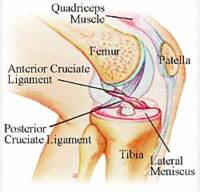 |
|
The Knee |
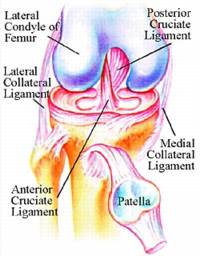 |
|
The Knee |
 |
|
Image 1 |
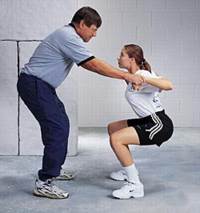 |
|
Image 2 |
 |
|
Image 3 |
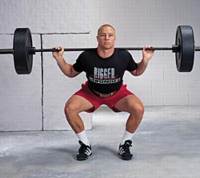 |
|
Image 4 |
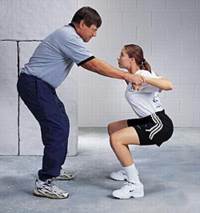 |
|
Image 5 |
 |
|
Image 7 |
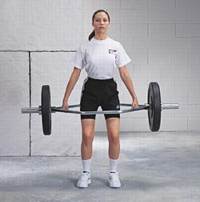 |
|
Image 8 |
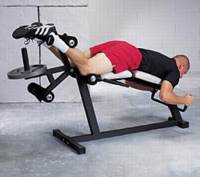 |
|
Image 9 |
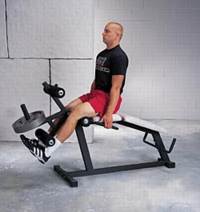 |
|
Image 10 |
 |
|
Image 11 |
 |
|
Image 12 |